ASIAN Regionalism Lecture CEU Summer School
advertisement
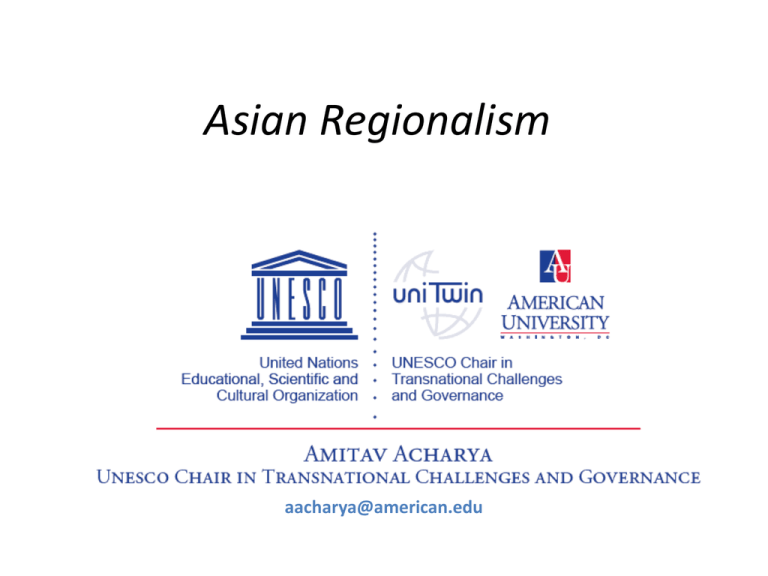
Asian Regionalism aacharya@american.edu • • • • • Evolution Characteristics Limitations Contributions Prospects and Reforms Asia (East, Southeast and South Asia) ASEAN Map Evolution • Pan-Asianism and Macro-Asianism (1947-1955). Asian Relations Conference, 1947; Conference on Indonesia, 1949; Colombo Powers, 1954-55; Bandung Conference, 1955 • ASEAN: 1967• Asia-Pacific Regionalism (Pacific Community idea, PECC, APEC): mid 1960s• East Asian Regionalism (EAEC, EAS, EAC): 1997• Sub-regionalism: SAARC, SCO, BIMSTEC Asian Subregional Institutions • ASEAN (1967). Three Communities by 2015 – ASEAN Economic Community (AEC): A common market of 600 m. people with 1.8 trillion combined GDP – ASEAN Political-Security Community (APSC): conflict resolution, counter-terrorism, anti-piracy measures, intelligence-sharing, disaster management – ASEAN Socio-Cultural Community (ASCC): create “people’s ASEAN”, build ASEAN identity, preserve environmental and natural resources. • South Asian Association for Regional Cooperation (SAARC) (1985): South Asian Free Trade Area, excludes bilateral disputes, focus on non-traditional security cooperation terrorism • Shanghai Cooperation Organization (SCO) (1995, 2001): confidencebuilding measures and fight “three evils” of terrorism, extremism, and separatism. Macroregional Institutions • Asia Pacific Economic Cooperation (1989) and APEC Leaders’ Meeting (1993): trade liberalization, but also security discussions, e.g. East Timor violence in 1999 and the 9/11 attacks in 2001 • ASEAN Regional Forum (1994): confidencebuilding, preventive diplomacy, disaster management and terrorist financing • East Asia Summit (2005): energy, environment, pandemics, poverty eradication, natural disaster mitigation, and finance. South China Sea conflict. Normative and Institutional Characteristics • Absence of Hegemonic Regionalism ( Due to “Capability-Legitimacy Gap”); ASEAN “centrality” as the basis for wider Asian regionalism, (Acharya, “Foundations of Collective Action in Asia”, http://papers.ssrn.com/sol3/papers.cfm?abstract_id=2005473) • Avoidance of collective defence and preference for cooperative security • Open regionalism, rather than EU Styleintegration • Soft institutionalism Criticisms • Weakly institutionalized, institutions and mechanisms underutilized, low compliance with agreements and treaties • Deliberative, and consultative, rather than problemsolving. Poor usage of available instruments of conflict prevention and resolution. • Uneven response to transnational issues, like air pollution, terrorism • Limited progress in regional economic integration • Limited role in promoting human rights and democracy • State-Centric, ignoring the people South China Sea Claims Why? • The problem of regional definition; No clear definition of the “region” • Addiction to sovereignty, non-intervention and the “ASEAN Way”. • Expansion of membership and functions • Presence of great powers in the region • Uncertain and indecisive leadership of ASEAN and Asian regional bodies • Impact of globalization Contributions of Asian Regionalism • • • • • • Constructing a Security Community in Southeast Asia (no major conflict among ASEAN members) Enhancing collective voice and bargaining capacity of Asian actors, small, medium or large Developing an active epistemic community in regional economic and security affairs Development-stability nexus: Allowing governments to focus on development because of reduction of intra-regional conflict Key role in resolving the Cambodia conflict and focusing international concern about the South China Sea dispute “Socialization” of China and other “newcomers”, including Vietnam, India and the US (see Acharya, Asian Regional Institutions and the Possibilities for. Socializing the Behavior of States,” ADB Working Paper, 2011). • • • Avoiding the US containment of China (Why is there still no NATO in Asia) Promoting inclusiveness and “Cooperative Security”. Engaging all the major powers of the world – China, US, Japan, India, Russia, EU) Thinking counterfactually: what if no regional institution in Asia? Challenges for the Future • Rise of China and India, a multipolar world • Increasing burden: scope of issues, and membership, and partnerships • Sovereignty and non-Interference in an age of globalization and transnational challenges • Compliance with new rules and the Charter: National interest version regional interest • ASEAN’s unity and cohesion Reforming Asian Regionalism • Mandate: From Dialogue to Action, from consultations to conflict resolution • Broadening and Strengthening Leadership • Legalization and Institutionalization • Avoiding Duplication of Tasks and Roles
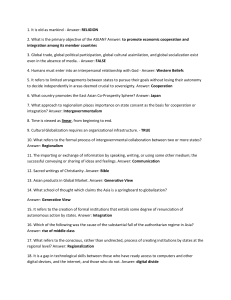
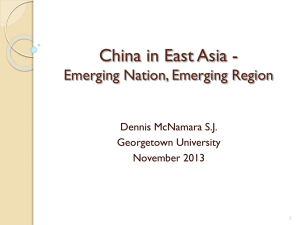
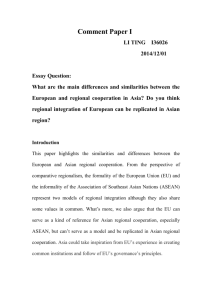
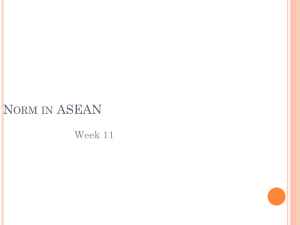

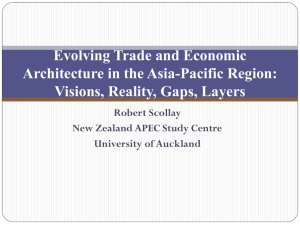

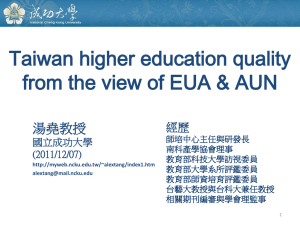
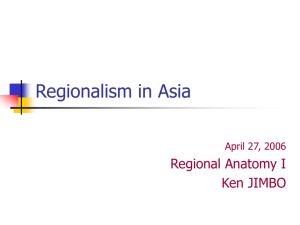

![A 3 bloc dance: East Asian regionalism and the North Atlantic trade giants by Richard Baldwin and Theresa Carpenter [PPT 950.50KB]](http://s2.studylib.net/store/data/014979456_1-559062731ba3ef6e63a1de4097f7f330-300x300.png)
